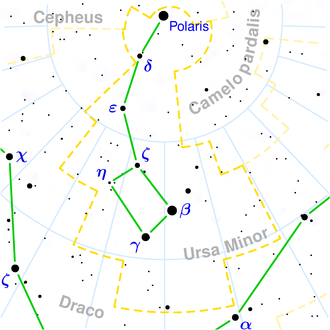NGC 6324
| Galaxy NGC 6324 |
|
|---|---|
![NGC 6324 with LEDA 214586 (r) [1] SDSS image](https://upload.wikimedia.org/wikipedia/commons/thumb/4/45/NGC6324_-_SDSS_DR14.jpg/300px-NGC6324_-_SDSS_DR14.jpg)
|
|
| NGC 6324 with LEDA 214586 (r) SDSS image | |
| AladinLite | |
| Constellation | Little Bear |
|
Position equinox : J2000.0 , epoch : J2000.0 |
|
| Right ascension | 17 h 05 m 25.318 s |
| declination | + 75 ° 24 ′ 25.30 ″ |
| Appearance | |
| Morphological type | Sbc |
| Brightness (visual) | 12.9 mag |
| Brightness (B-band) | 13.7 mag |
| Angular expansion | 1.0 ′ × 0.6 ′ |
| Position angle | 72 ° |
| Surface brightness | 12.2 mag / arcmin² |
| Physical data | |
| Redshift | 0.016231 ± 0.000127 |
| Radial velocity | 4866 ± 38 km / s |
|
Stroke distance v rad / H 0 |
(226 ± 16) x 10 6 ly (69.2 ± 4.9) Mpc |
| history | |
| discovery | Wilhelm Herschel |
| Discovery date | December 12, 1797 |
| Catalog names | |
| NGC 6324 • UGC 10725 • PGC 59583 • CGCG 355-025 • MCG + 13-12-016 • IRAS 17070 + 7528 • 2MASX J17052594 + 7524267 • GC 4282 • H III 945 • GALEX ASC J170525.47 + 752425.7 • NVSS J170525 + 752427 | |
NGC 6324 is a 12.9 likes bright spiral galaxy of Hubble type Sbc in the constellation Ursa Minor at the northern sky . It is an estimated 226 million light-years from the Milky Way and about 65,000 light-years across.
The type II supernova SN 2002ej was observed here.
The object was discovered on December 12, 1797 by Wilhelm Herschel with an 18.7-inch reflector telescope, who described it as "vF, S, E, north of a small star".
Web links
- NGC 6324. SIMBAD , accessed on July 20, 2019 (English).
- NGC 6324. DSO Browser, accessed July 20, 2016 .
